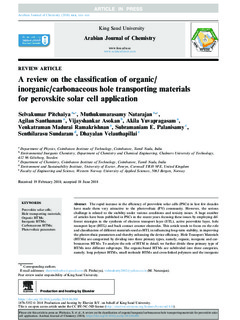| dc.contributor.author | Selvakumar, P | |
| dc.contributor.author | Muthukumarasamy, N. | |
| dc.contributor.author | Agilan, S | |
| dc.contributor.author | Asokan, Vijayashankar | |
| dc.contributor.author | Akila, Y | |
| dc.contributor.author | Venkatraman, M R | |
| dc.contributor.author | Palanisamy, Subramaniam E, | |
| dc.contributor.author | Senthilarasu, S | |
| dc.contributor.author | Velauthapillai, Dhayalan | |
| dc.date.accessioned | 2019-02-14T13:38:14Z | |
| dc.date.available | 2019-02-14T13:38:14Z | |
| dc.date.created | 2018-07-31T15:10:14Z | |
| dc.date.issued | 2018 | |
| dc.identifier.citation | Pitchaiya, S., Natarajan, M., Santhanam, A., Asokan, V., Yuvapragasam, A., Madurai Ramakrishnan, V., . . . Velauthapillai, D. (2018). A review on the classification of organic/inorganic/carbonaceous hole transporting materials for perovskite solar cell application. Arabian Journal of Chemistry. | nb_NO |
| dc.identifier.issn | 1878-5352 | |
| dc.identifier.uri | http://hdl.handle.net/11250/2585535 | |
| dc.description.abstract | The rapid increase in the efficiency of perovskite solar cells (PSCs) in last few decades have made them very attractive to the photovoltaic (PV) community. However, the serious challenge is related to the stability under various conditions and toxicity issues. A huge number of articles have been published in PSCs in the recent years focusing these issues by employing different strategies in the synthesis of electron transport layer (ETL), active perovskite layer, hole transport layer (HTL) and back contact counter electrodes. This article tends to focus on the role and classification of different materials used as HTL in influencing long-term stability, in improving the photovoltaic parameters and thereby enhancing the device efficiency. Hole Transport Materials (HTMs) are categorized by dividing into three primary types, namely; organic, inorganic and carbonaceous HTMs. To analyze the role of HTM in detail, we further divide these primary type of HTMs into different subgroups. The organic-based HTMs are subdivided into three categories, namely; long polymer HTMs, small molecule HTMs and cross-linked polymers and the inorganic HTMs have been classified into nickel (Ni) derivatives and copper (Cu) derivatives based HTMs, p-type semiconductor based HTMs and transition metal based HTMs. We further analyze the dual role of carbonaceous materials as HTM and counter electrode in the perovskite devices. In addition, in this review, an overview of the preparation methods, and the influence of the thickness of the HTM layers on the performance and stability of the perovskite devices are also provided. We have carried out a detailed comparison about the various classification of HTMs based on their cost-effectiveness and considering their role on effective device performance. This review further discusses the critical challenges involved in the synthesis and device engineering of HTMs. This will provide the reader a better insight into the state of the art of perovskite solar devices. | nb_NO |
| dc.language.iso | eng | nb_NO |
| dc.publisher | Elsevier | nb_NO |
| dc.rights | Attribution-NonCommercial-NoDerivatives 4.0 Internasjonal | * |
| dc.rights.uri | http://creativecommons.org/licenses/by-nc-nd/4.0/deed.no | * |
| dc.subject | perovskite solar cells | nb_NO |
| dc.subject | hole transporting materials | nb_NO |
| dc.subject | organic HTMs | nb_NO |
| dc.subject | inorganic HTMs | nb_NO |
| dc.subject | carbonaceous HTMs | nb_NO |
| dc.subject | photovoltaic parameters | nb_NO |
| dc.title | A Review on the Classifications of Organic/Inorganic/Carbonaceous Hole Transporting Materials for Perovskite Solar Cell Application | nb_NO |
| dc.type | Journal article | nb_NO |
| dc.type | Peer reviewed | nb_NO |
| dc.description.version | publishedVersion | nb_NO |
| dc.source.journal | Arabian Journal of Chemistry | nb_NO |
| dc.identifier.doi | 10.1016/j.arabjc.2018.06.006 | |
| dc.identifier.cristin | 1599220 | |
| cristin.unitcode | 203,2,30,0 | |
| cristin.unitname | Institutt for data- og realfag - Bergen | |
| cristin.ispublished | true | |
| cristin.fulltext | original | |
| cristin.qualitycode | 1 | |

